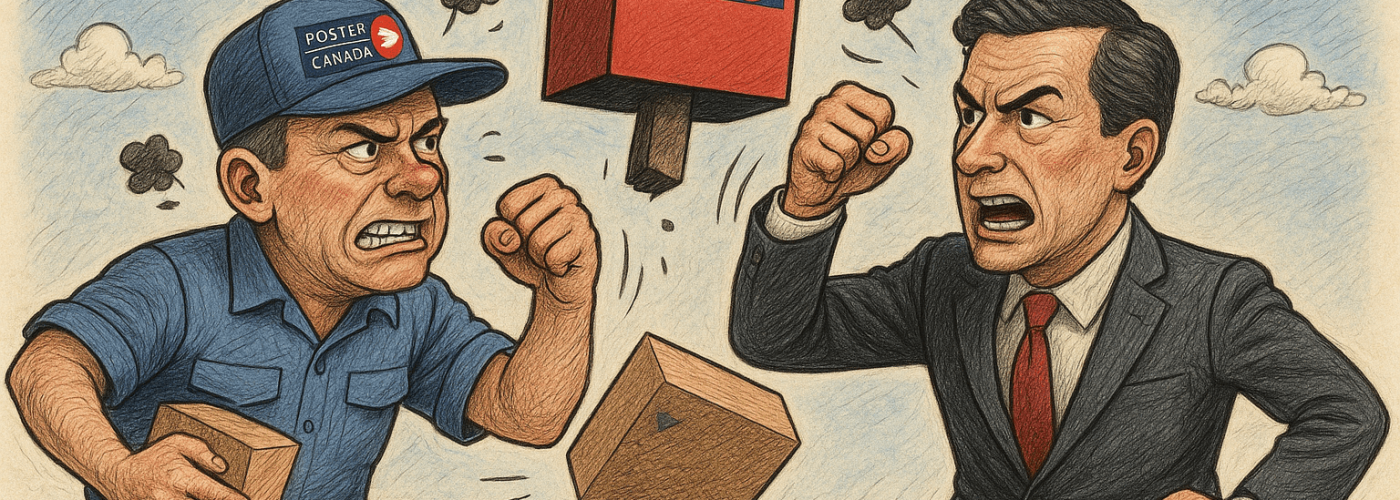The air is thick with tension at Canada Post once again. As of today, postal workers, represented by the Canadian Union of Postal Workers (CUPW), have initiated a national overtime ban. While full-blown strike action hasn’t begun, the possibility looms large, casting a dark shadow over a Crown corporation already teetering on the brink of financial collapse. This latest Canada Post strike action, even in its current limited form, forces us to ask some hard questions about the future of our national postal service.
Let’s be clear: unions are, by and large, a cornerstone of fair labour. When we’re talking about multinational, billion-dollar profit-making behemoths, unions are often the only line of defence for workers. They fight for fair wages, safe working conditions, and a share in the massive profits these corporations rake in. In that arena, the power of collective bargaining, including the right to strike, is a vital tool to ensure Goliaths don’t trample Davids.
But the narrative shifts uncomfortably when we look at Canada Post. This isn’t a story of a rapacious private company swimming in cash. Canada Post is a publicly owned entity that has been haemorrhaging money for years. Reports indicate staggering losses, to the tune of $3 billion since 2018, with a pre-tax loss of $748 million in 2023 alone. The corporation recently required a billion-dollar federal loan just to stay afloat. We’re talking about an organization described as “effectively bankrupt” and facing an “existential crisis.”
This is where the current Canada Post strike threat becomes so perilous. The core issues in the dispute – wages, benefits, pensions, and particularly Canada Post’s desire to introduce more part-time weekend workers to compete in the booming parcel delivery market – are understandable from the union’s perspective of protecting its members. However, for an entity losing billions, can traditional strike tactics achieve their aims without potentially sinking the ship entirely?
What’s Going On? A Perfect Storm.
Letter mail volumes have plummeted in the digital age, a trend that won’t reverse. While parcel delivery is a growth area, Canada Post faces fierce competition from nimble private sector players who aren’t bound by the same legacy structures or, in some cases, labour agreements. Canada Post wants more flexibility, like part-time weekend work, to adapt. The union, understandably, views such moves with suspicion, fearing an erosion of good, full-time jobs. Just six months ago, in late 2024, a disruptive Canada Post strike highlighted these very tensions.

Negotiations have been tense, with the union arguing its members deserve fair compensation, especially after years of inflationary pressures. Canada Post, on the other hand, points to its dire financial straits, arguing that without significant operational changes, it simply cannot survive. An industrial inquiry commissioner recently even recommended drastic measures like ending door-to-door delivery for homes.
How Will a Canada Post Strike Affect the Situation?
Even the current overtime ban will cause delays and inefficiencies, further frustrating customers and potentially driving more business to competitors. If this escalates into a full-blown Canada Post strike, the consequences could be devastating:
- Accelerated Financial Ruin: A work stoppage means a halt in revenue, deepening the financial hole and making a return to stability even harder.
- Loss of Customer Confidence: Businesses, especially small and medium-sized enterprises and e-commerce retailers who rely on Canada Post, will be forced to find alternatives. Many may not return, further eroding Canada Post’s market share. The previous Canada Post strike already tested their patience.
- Public Backlash: While public sympathy often lies with workers, a strike that disrupts an essential service already perceived as struggling can breed resentment, especially when taxpayer money is involved in keeping it afloat.
- Weakened Negotiating Position (Potentially for Both Sides): If a strike pushes Canada Post closer to insolvency, it could lead to more drastic government intervention, potentially resulting in outcomes less favourable than a negotiated settlement for both the corporation and its employees. Not to mention, it makes us less reliant on them, finding alternate solutions that may just stay in place long after the conflict is resolved.
No one wants to see workers’ rights diminished. But in the case of Canada Post, a vital public service drowning in red ink, one has to wonder if a traditional Canada Post strike is less a tool for leverage and more a step towards an abyss from which there’s no return. Finding a path forward requires a delicate balance between protecting workers and confronting the brutal economic realities threatening to make the iconic red and white a relic of the past. The question isn’t just about winning a labour dispute; it’s about whether Canada Post itself can survive to offer any jobs at all.



